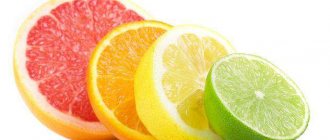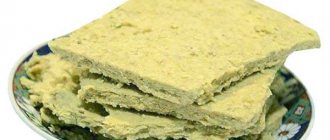Nutritionists and adherents of a healthy lifestyle constantly talk about the benefits of fiber - dietary fiber contained in foods of plant origin.
And this is not surprising - with its help you can easily maintain normal intestinal microflora.
Fiber itself is practically not digested in the gastrointestinal tract and does not contain vitamins, which theoretically makes it useless.
But at the same time, hard fibers are necessary for well-being, digestion and intestinal function.
We understand foods rich in fiber, how it works, and make a list of must-have dishes to include in the menu.
Fiber-rich foods - benefits and contraindications
Why doesn't our body want/can't digest fiber?
The answer is simple: it will take a lot of time to process the rough parts of plants, but their transit through the body ensures cleansing of food waste, waste and toxins, and the presence of carbohydrates is necessary for a feeling of fullness.
For this reason, dietary fiber can be considered the intestinal orderlies and the best friends of a thin waist.
Unlike food, which goes through a long process of digestion, fiber is excreted in its original form, however, it can be soluble and insoluble.
What does this mean: in a healthy intestine with balanced microflora, bacteria live that can destroy hard dietary fiber.
With their help, soluble compounds are formed in the large intestine. They take on a jelly-like state and are partially absorbed.
Fiber is found in vegetables and fruits
The degree of solubility can be determined by the peel of the fruit - the thinner and softer it is, the more the fibers are broken down.
The soluble group consists of resins, alginates, and pectins. Insoluble - cellulose, lignin, hemicellulose.
8 beneficial properties of fiber:
- Restores proper functioning and activates intestinal motility - the diet is prescribed for hemorrhoids and constipation
- Stimulates weight loss - thanks to high satiety, the feeling of hunger recedes, portions are reduced in size
- Reduces blood sugar and controls cholesterol levels - indicated for diabetes of all types, for the prevention of cardiovascular diseases
- Cleanses the lymphatic system
- Removes toxins, waste, unnecessary fats, stomach and intestinal mucus, is a natural absorbent
- Strengthens muscle fibers
- Prevents cancer, including rectal cancer
- Minimizes putrefactive processes
Of course, some foods rich in fiber have a number of contraindications, and if consumed in excess, can cause bloating and impaired absorption of other nutrients.
Ballast dietary fiber swells in the intestines and, like a sponge, absorbs excess moisture
These include:
- Apples
- Grapefruits
- Tomatoes
- Strawberry
- Cabbage
- Cereals
- Bran
You should be careful when enriching your diet with them in case of inflammation of the mucous membrane of the intestines and stomach, acute infectious diseases, and problems with blood circulation.
What products contain soluble?
Soluble fiber or pectin. Mainly found in berries, fruits, oat bran and leafy salads. It is important to provide the body with both types of fiber. The recommended proportion of soluble and insoluble is 3 to 1.
Now a little more about them. Plant foods contain fiber in approximately this ratio
- 1-2% by weight of fruit or vegetable
- 3-5% of berry weight
- 2% of mushroom mass
The fiber intake per day should be 25 grams. This is approximately 1250 gr. fruits, vegetables and mushrooms or 650 grams of berries. But don’t rush to be surprised and give up. Fiber is also found in other foods.
One study found that consuming an average of 5 fruits and/or vegetables per day can significantly reduce the risk and even prevent cardiovascular disease. 5 is a completely feasible daily intake of fruits and vegetables.
This is approximately 1 kg. Plus coarse fiber in side dishes, nuts, seeds, etc. Thus, we get the recommended ratio of 3 to 1 and 25 grams per day. You can use this formula as a guide when creating your daily menu. Now about products containing plant fiber.
About the benefits of flaxseed oil->>
Foods rich in fiber and dietary fiber - table with descriptions
Porridges contain a lot of hard dietary fiber.
Fiber is a food of plant origin.
Vegetables, fruits, cereals, bran, dried fruits, legumes, wholemeal bread - fiber is concentrated in seeds, stems, peel.
In fruits the mass reaches 2%, in berries - 3-5%, in mushrooms - 2%. Seeds contain a large amount of insoluble fiber.
Soluble - berries, oat bran and leafy vegetables.
A balanced diet based on this completely covers the daily requirement for dietary fiber without additional additives.
Tip: 25 g is exactly how much insoluble fiber a person needs daily to maintain intestinal health.
The list below contains foods that contain the most dietary fiber.
It is important to remember that when cooked, vegetables lose fiber, which is why it is better to eat them “live”.
Choose brown rice
Seeds - flax, pumpkin, sunflower, sesame
Bread made from whole grain flour, coarsely ground, with bran
Crispbread from cereals and cereals
Give up unhealthy sweets in favor of dried fruits
Nuts - almonds, hazelnuts, walnuts, cashews, pistachios, peanuts
Cereals - pearl barley, buckwheat, oatmeal, wheat
Rice - peeled, unpeeled, brown
All instant porridges that do not require cooking do not contain coarse dietary fiber. Although they are convenient to prepare, they are useless for health.
Dried fruits - dates, raisins, dried apricots
Vegetables without heat treatment - asparagus, spinach, broccoli, white cabbage, carrots, radishes, cucumbers, potatoes, beets, tomatoes, pumpkin
Give preference to wholemeal and bran bread
Berries and fruits - black currants, raspberries, strawberries, bananas, apricots, peaches, apples, pears, grapes
But dairy products and all their derivatives, alas, do not contain fiber.
It is not found in premium flour, oils or freshly squeezed juices. To enrich the latter with dietary fiber, you should give preference to smoothies.
Vegetables and fruits should not be peeled - the peels of apples and pears contain the largest amount of fiber. This does not apply to avocados.
We also clean imported apples - during long-term transportation of fruits, the peel is always treated with chemical compounds that are a priori not useful.
Particular attention should be paid to bran
Tip: In vegetables, fiber is concentrated in different parts. In carrots, for example, in the core, and in beets - in the rings inside.
Separately, it is worth mentioning bran.
All of them - rice, corn, wheat, barley, oatmeal and rye - not only contain a huge amount of dietary fiber, but are also a natural absorbent.
They contain vitamins B, E, nicotinic acid, zinc, chromium, magnesium, selenium and a number of other useful microelements.
You can buy them at a pharmacy or health food department. The optimal dose for cleansing the intestines is one tablespoon three times a day.
If at the same time you take medications as prescribed by a doctor, at least six hours should pass after taking bran, since they have the ability to actively remove all foreign elements.
Diet bread
Fiber can also be purchased in the form of preparations containing both types of fiber.
Its regular intake quickly replenishes the deficiency of ballast substances, however, nutritionists recommend resorting to this method as a last resort and limiting yourself to a properly structured menu.
High Fiber Foods Chart
In these tables, the average daily requirement for fiber is assumed to be 30 g. The “Percentage of daily requirement” column shows the percentage of 100 grams of product that satisfies a person’s daily need for fiber.
| Fiber content in cereals, grain products and legumes | Fiber content in vegetables and herbs | ||||
| The product's name | Fiber content per 100g | Percentage of daily requirement | The product's name | Fiber content per 100g | Percentage of daily requirement |
| Wheat bran | 43.6 g | 145% | Horseradish (root) | 7.3 g | 24% |
| Rye (grain) | 16.4 g | 55% | Parsnip (root) | 4.5 g | 15% |
| Oat bran | 15.4 g | 51% | Jerusalem artichoke | 4.5 g | 15% |
| Barley (grain) | 14.5 g | 48% | Brussels sprouts | 4.2 g | 14% |
| Buckwheat (grain) | 14 g | 47% | Dandelion leaves (greens) | 3.5 g | 12% |
| Soybean (grain) | 13.5 g | 45% | Parsley (root) | 3.2 g | 11% |
| Rye wallpaper flour | 13.3 g | 44% | Rhubarb (greens) | 3.2 g | 11% |
| Buckwheat (prodel) | 12.5 g | 42% | Bulb onions | 3 g | 10% |
| Peeled rye flour | 12.4 g | 41% | Celery (root) | 3.1 g | 10% |
| Beans (grain) | 12.4 g | 41% | Broccoli | 2.6 g | 9% |
| Oats (grain) | 12 g | 40% | Cilantro (greens) | 2.8 g | 9% |
| Buckwheat (kernel) | 11.3 g | 38% | Dill (greens) | 2.8 g | 9% |
| Wheat (grain, durum) | 11.3 g | 38% | Eggplant | 2.5 g | 8% |
| Lentils (grain) | 11.5 g | 38% | Carrot | 2.4 g | 8% |
| Mash | 11.1 g | 37% | Beet | 2.5 g | 8% |
| Peas (shelled) | 10.7 g | 36% | Swede | 2.2 g | 7% |
| Seeded rye flour | 10.8 g | 36% | Ginger (root) | 2 g | 7% |
| Wheat (grain, soft variety) | 10.8 g | 36% | White cabbage | 2 g | 7% |
| Buckwheat flour | 10 g | 33% | Cauliflower | 2.1 g | 7% |
| Chickpeas | 9.9 g | 33% | Leek | 2.2 g | 7% |
| Rice (grain) | 9.7 g | 32% | Parsley (greens) | 2.1 g | 7% |
| Wheat flour | 9.3 g | 31% | Black radish | 2.1 g | 7% |
| Oatmeal | 8 g | 27% | Pumpkin | 2 g | 7% |
| Barley groats | 8.1 g | 27% | Kohlrabi cabbage | 1.7 g | 6% |
| Pearl barley | 7.8 g | 26% | Red cabbage | 1.9 g | 6% |
| Wheat flour 2 grades | 6.7 g | 22% | Sweet pepper (Bulgarian) | 1.9 g | 6% |
| Oat flakes "Hercules" | 6 g | 20% | Turnip | 1.9 g | 6% |
| Green peas (fresh) | 5.5 g | 18% | Celery (greens) | 1.8 g | 6% |
| Pasta made from 1st grade flour | 5.1 g | 17% | Basil (greens) | 1.6 g | 5% |
| Corn grits | 4.8 g | 16% | Potato | 1.4 g | 5% |
| Oat flour (oatmeal) | 4.8 g | 16% | Pomodoro (tomato) | 1.4 g | 5% |
| Wheat flour 1st grade | 4.9 g | 16% | Radish | 1.6 g | 5% |
| Wheat groats | 4.6 g | 15% | Asparagus (greens) | 1.5 g | 5% |
| Corn flour | 4.4 g | 15% | Garlic | 1.5 g | 5% |
| Oat flour | 4.5 g | 15% | Cabbage | 1.2 g | 4% |
| Semolina | 3.6 g | 12% | Watercress (greens) | 1.1 g | 4% |
| Millet groats (polished) | 3.6 g | 12% | Green onion (feather) | 1.2 g | 4% |
| Premium flour pasta | 3.7 g | 12% | Lettuce (greens) | 1.2 g | 4% |
| Premium wheat flour | 3.5 g | 12% | Spinach (greens) | 1.3 g | 4% |
| Green beans) | 3.4 g | 11% | Sorrel (greens) | 1.2 g | 4% |
| Rice groats | 3 g | 10% | Zucchini | 1 g | 3% |
| Sweet corn | 2.7 g | 9% | Cucumber | 1 g | 3% |
| Rice flour | 2.3 g | 8% | Savoy cabbage | 0.5 g | 2% |
| — | — | — | Sea kale | 0.6 g | 2% |
| Fiber content in fruits, dried fruits and berries | Fiber Content of Nuts and Seeds | ||||
| The product's name | Fiber content per 100g | Percentage of daily requirement | The product's name | Fiber content per 100g | Percentage of daily requirement |
| Dried figs | 18.2 g | 61% | Pistachios | 10.6 g | 35% |
| Dried apricots | 18 g | 60% | Peanut | 8.1 g | 27% |
| Dried apricots | 17.6 g | 59% | Almond | 7 g | 23% |
| Dried peach | 14.9 g | 50% | Walnut | 6.1 g | 20% |
| Dried apples | 14.9 g | 50% | Hazelnut | 6 g | 20% |
| Rose hip | 10.8 g | 36% | Sesame | 5.6 g | 19% |
| Raisin | 9.6 g | 32% | Sunflower seeds (seeds) | 5 g | 17% |
| Prunes | 9 g | 30% | Pine nut | 3.7 g | 12% |
| Avocado | 6.7 g | 22% | Cashew | 2 g | 7% |
| Cloudberry | 6.3 g | 21% | |||
| Feijoa | 6.4 g | 21% | |||
| Dried pear | 6 g | 20% | |||
| Dates | 6 g | 20% | |||
| Red rowan | 5.4 g | 18% | |||
| Black currant | 4.8 g | 16% | |||
| Rowan chokeberry | 4.1 g | 14% | |||
| Durian | 3.8 g | 13% | |||
| Kiwi | 3.8 g | 13% | |||
| Quince | 3.6 g | 12% | |||
| Raspberries | 3.7 g | 12% | |||
| Cranberry | 3.3 g | 11% | |||
| Gooseberry | 3.4 g | 11% | |||
| White currant | 3.4 g | 11% | |||
| Red currants | 3.4 g | 11% | |||
| Blackberry | 2.9 g | 10% | |||
| Blueberry | 3.1 g | 10% | |||
| Pear | 2.8 g | 9% | |||
| Cowberry | 2.5 g | 8% | |||
| Blueberry | 2.5 g | 8% | |||
| Fresh figs | 2.5 g | 8% | |||
| Apricot | 2.1 g | 7% | |||
| Orange | 2.2 g | 7% | |||
| Strawberries | 2.2 g | 7% | |||
| Lemon | 2 g | 7% | |||
| Sea buckthorn | 2 g | 7% | |||
| Peach | 2.1 g | 7% | |||
| Cherry plum | 1.8 g | 6% | |||
| Banana | 1.7 g | 6% | |||
| Cherry | 1.8 g | 6% | |||
| Grapefruit | 1.8 g | 6% | |||
| Mandarin | 1.9 g | 6% | |||
| Nectarine | 1.7 g | 6% | |||
| Papaya | 1.7 g | 6% | |||
| Apples | 1.8 g | 6% | |||
| Grape | 1.6 g | 5% | |||
| Mango | 1.6 g | 5% | |||
| Plum | 1.5 g | 5% | |||
| Persimmon | 1.6 g | 5% | |||
| A pineapple | 1.2 g | 4% | |||
| Cherries | 1.1 g | 4% | |||
| Pomegranate | 0.9 g | 3% | |||
| Melon | 0.9 g | 3% | |||
| Pomelo | 1 g | 3% | |||
| Watermelon | 0.4 g | 1% | |||
From our article you learned about the main properties of fiber and foods rich in fiber. Fiber is also good for weight loss.
Fiber-rich foods - list and rules for reasonable weight loss
Eat nuts in small quantities
Inspired by encouraging information about the ability of fiber to swell in the stomach and remove all harmful substances, many girls begin to mindlessly abuse a diet based on dietary fiber.
It, without a doubt, works, but if the norm increases to more than 40 g per day, it can seriously harm your well-being.
Along with the bran, beneficial substances and vitamins will begin to be excreted, and they will be accompanied by bloating and increased gas formation.
Add seeds to salads
To prevent this from happening, American Dietetic Association Health nutrition specialist Julia Upton has developed a number of simple rules:
- 16-20 g of fiber daily provides 800 g of vegetables and fruits with peel
- Porridge made from barley, brown rice, buckwheat and oatmeal will bring another 5-7 grams
- 5-6 grams contain 100 g of wholemeal bread
- Twice a week, diversify the menu with lentils, peas and beans
- Don't eat confectionery sugar, replace unhealthy treats with dried fruits
- Small snacks should consist of nuts and seeds
- Eat steamed bran - 6 tablespoons per day
Tip: for better digestion of food, leave fruits for the first half of the day and give up the bad habit of washing down your food with water.
It is important to remember that a quarter of the daily menu for weight loss should consist of fresh salads.
Another quarter is fruits, a quarter is cooked vegetables, a tenth is legumes and cereals, the same amount is fermented milk, milk and nuts, and a twentieth is vegetable fats.
The basis of losing weight on fiber is fresh salads
By losing weight in this way, you can actually lose from two to four kilograms in a month with the help of a competent diet alone.
To make the process smooth and painless, create a menu based on foods rich not only in fiber, but also in vegetable proteins and fats.
Prepare a wider variety of dishes based on:
- Beans, soy, brown rice and chickpeas
- Add pumpkin seeds, almonds, walnuts, cashews and hazelnuts to fresh salads
- Fortify yourself with spinach and avocado
- Don't forget Brussels sprouts, artichokes and broccoli
- Within reason, indulge yourself with bananas, raspberries, pears, apples
Quinoa seeds are also rich in the benefits listed above - they are a source of omega-3 fatty acids, protein, calcium, zinc, magnesium and iron.
They are used to prepare porridges, grind them into flour and bake bread. Quinoa has practically no taste, so you can’t do without spices.
Choose smoothies instead of juices
What is the daily fiber requirement for an adult and a child?
Modern nutritionists believe that the daily fiber intake is approximately 30-50 g for an adult, and for children 10 g + 1 g for each year of life. That is, it is normal for a 10-year-old child to consume at least 20 g of fiber per day.
- For those who want to say goodbye to extra pounds, the daily norm should be close to 35 g. But you should not immediately load your stomach with a full dose of fiber, since the body of a modern urban person is accustomed to more gentle food. If you suddenly switch to proper nutrition with foods that contain “coarse” fiber, you can get bloating and indigestion.
- During heat treatment, the structure of the fibers expands, thus to some extent losing its beneficial detoxifying properties, therefore it is recommended to consume vegetables and fruits raw. But if your body reacts negatively when eating raw food, then the best way out of this situation would be to steam the dish or simmer it a little, trying to leave the vegetables a little undercooked.
- For an expectant mother, fiber should make up a significant part of the diet. At a minimum, this is useful in the last months of pregnancy, since fiber acts as a means of preventing constipation. In the last few months, the baby puts significant pressure on the entire food system and the problem of constipation is familiar to every third pregnant woman.
Fiber intake rate
- The norm for expectant mothers is 25%. Exceeding the norm can cause a feeling of flatulence, frequent bowel movements, abdominal pain, which will create discomfort, and is completely unnecessary for girls in the “position”.
- Fiber is also useful for pregnant women because during this period women often experience an inadequate increase in blood glucose levels and a decrease in insulin sensitivity, which can later lead to gestational diabetes. This anomaly is detrimental to the life of both the unborn baby and the mother. Fiber acts as a natural “regulator” of glucose levels in the body, and that is why it is recommended for women.
- It is advisable to take the daily norm, divided into parts and consume before basic meals. But we must not forget that coarse fibers should enter the body gradually; add 5 g of fiber to your meals every day.
The benefits of fiber for hemorrhoids
Eating foods rich in fiber (see the section above for a complete list) is especially important for hemorrhoids.
Hard dietary fiber, like a sponge, absorbs large amounts of moisture and softens stool, facilitating its passage through the rectum without irritating the mucous membrane.
The basis of the diet should be fresh vegetables, fruits, cereals, bananas, dried apricots, prunes and 60 grams of bran daily.
We still peel the avocado
You should adhere to the following nutritional rules:
- Eat 5-6 times a day in small portions
- Give preference to buckwheat, barley, pearl barley and oatmeal porridge
- Choose bread from wholemeal, bran and black flour
- Avoid baked goods and pasta
- Choose the right vegetables: beets, cauliflower, broccoli, cucumbers, zucchini, raw, stewed and steamed carrots
- Drink 1.5-2 liters of water per day
- Limit tea, coffee, alcohol
Steam vegetables
What are the dangers of a lack of fiber in foods?
There is no fiber in animal products; you can only get it from plant foods.
If you don’t consume fiber, it’s quite difficult to get enough, since it is plant fiber that suppresses the appetite hormone – ghrelin.
Thanks to fiber, sugar enters the blood gradually, which prevents the development of diabetes. Plant fibers contain a huge amount of vitamins and nutrients, and therefore strengthen the immune system. For these reasons, plant fibers should be present in the daily human diet.
Fiber-rich foods - list of foods allowed during pregnancy
Hard dietary fiber in the diet of expectant and young mothers is an effective prevention of constipation and obesity.
Daily consumption rate is 28-30 grams. This is enough for regular bowel movements and maintaining stable sugar levels.
During pregnancy and lactation, fiber foods are essential for your body.
- Focus on fresh vegetables and fruits; do not peel apples, pears, or peaches
- Choose whole grain bread
- Eat wheat, rye and rice bran
- Prepare lentil and pea dishes
But during feeding, it is better to avoid too coarse fiber and products containing it:
- Beans
- Dill
- Sweet pepper
- Broccoli
- Brown rice
- Corn
- Soybeans
- Beans
- Coarse flour
Cook porridge in water
What is fiber for?
First of all, to get the most benefits from consuming fiber, you need to drink enough water. Dietary fiber stabilizes the process of excretion of feces, that is, prevents the development of diarrhea and constipation. They enhance gastrointestinal motility and slow down the rate of digestion of incoming food, resulting in a faster feeling of satiety.
In addition, plant fibers help remove heavy metals and toxic substances from the body. Allows you to get rid of toxins and stabilize blood sugar levels. Thanks to the regular intake of fiber into the body, the bile ducts are cleaned, thereby reducing the risk of stagnation and stones.
Fibers begin to exert their beneficial effects even at the stage of chewing in the mouth, stimulating salivation. While a person chews fiber, teeth are cleaned. When eating such food, a person eats less because he chews longer, and this allows him to get full faster and not overeat.
Thanks to plant fibers, the risk of developing pathologies associated with the gastrointestinal tract is reduced. Feces are completely excreted and do not accumulate. Fiber retains substances and liquids 30-50 times its own weight.
Fiber contains a lot of potassium, which has a diuretic effect. Accordingly, thanks to it, excess fluid and sodium are removed.
Eating foods high in fiber every day can help prevent colon cancer. Evidence of this can be found in Japan, where people eat beans, soy or rice every day. The incidence of gastrointestinal tract diseases in this country is low when compared with the United States or Europe.
If there is a deficiency of fiber in the diet, then problems with the intestines appear, which at first are completely innocent, but if the situation is not corrected, then everything can end in obstruction or even cancer.
Harmful fiber contraindications
When consuming fiber, you must drink enough water, otherwise dehydration will occur. And such a condition is fraught with dire consequences for the human body. For the same reason, due to a lack of fluid in the body, constipation may occur.
If you get too carried away with eating fiber, you can deprive your body of a large amount of nutrients and minerals. Excess fiber can also cause bloating and flatulence.
Despite the fact that fiber stabilizes the digestive process, an excess of it increases the risk of diarrhea. This is due to the fact that plant fibers begin to practically push food out of the body until the digestive process is completed. Hence the conclusion is that after such a meal the body will not receive all the nutrients it needs from food.










